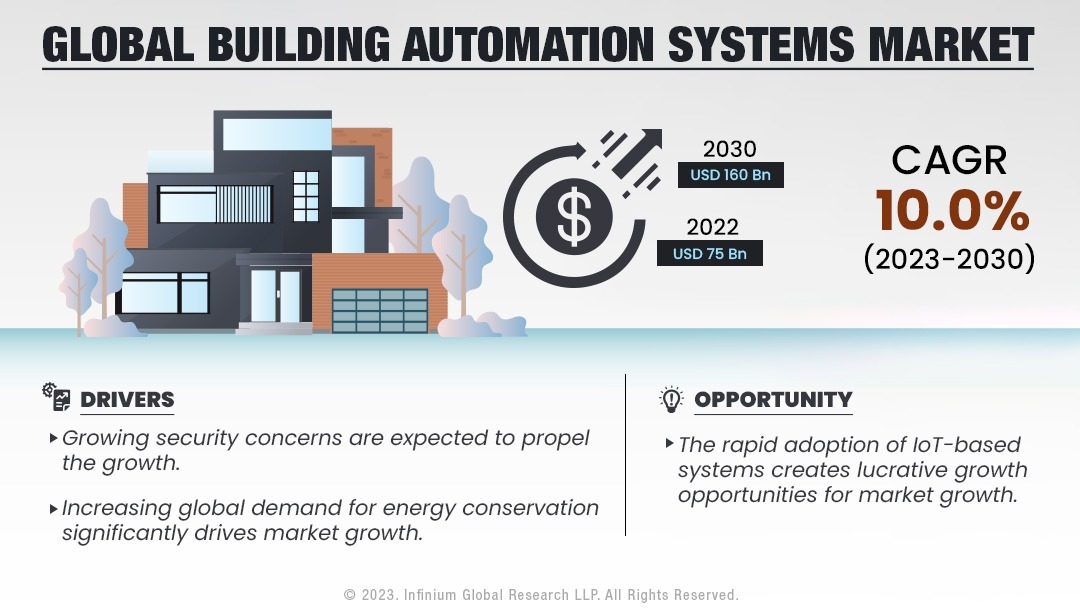Building Automation Systems Market (Offering - Facility Management Systems, Security and Access Controls, Fire Protection Systems, Building Energy Management Software, BAS Services, and Others; Application - Residential, Commercial, and Industrial; Communication Technology - Wired Technology, and Wireless Technology): Global Industry Analysis, Trends, Size, Share and Forecasts to 2030
A recent report published by Infinium Global Research on building automation systems market provides in-depth analysis of segments and sub-segments in the global as well as regional building automation systems market. The study also highlights the impact of drivers, restraints, and macro indicators on the global and regional building automation systems market over the short term as well as long term. The report is a comprehensive presentation of trends, forecast and dollar values of global building automation systems market.
Market Insight:
Software, sensors, and non-HVAC controllers experienced higher-than-average growth. Building automation system solutions are increasingly expanding out from their traditional role in managing HVAC to embrace other areas of building technology. The post-pandemic environment needs to offer a higher level of safety and control of buildings which might boost sales of software, sensors, and access control systems. With most critical buildings still running and disconnected from operators, cloud-based remote building automation system operations can be an invaluable advantage, during times that necessitate lean operations and reduced operational expenditures. The rapid adoption of IoT-based systems with the promise of significantly reducing operational costs is driving rapid growth in the building and facility automation marketplace. The purpose of these systems is to reduce energy consumption, improve occupant comfort, and total cost of ownership, efficiently operate building systems, and increase the lifecycle of utilities.
The rise of the Internet of Things, Industry 4.0, and other sweeping technology initiatives are creating a huge wave of IT adoption at every level of the building system architecture. Buildings today are becoming more advanced and the demands on building services are increasing. A modern building is expected to provide a number of services with high security, energy efficiency, and convenience. For a building with complex requirements due to the activity, such as a hospital, the services provided are even more advanced and the requirements on them are higher. This implies the need for a building automation system. The global building automation systems market is driven by factors such as regulatory norms, the requirement for superior utility efficiency, increasing global demand for energy conservation, and growing security concerns. Additionally, the rapid growth of IoT is expected to help in market growth during the forecasted period. However, the high cost of implementation, technical difficulties, and lack of skilled experts are affecting the growth of the market. Moreover, favorable government initiatives will provide lucrative growth opportunities for the building automation system market. Government initiatives for reducing carbon emission & improving energy efficiency are likely to provide lucrative opportunities for the market to grow over the forecast period.

The Asia Pacific dominates the building automation systems market. A surge in construction and industrial activities witnessed is driving the growth of the building automation system market in the Asia Pacific region. Emerging countries such as China and India have increasingly started developing smart cities. Moreover, increasing government initiatives towards energy conservation are also likely to contribute to the growth of the building automation system market in the Asia Pacific region.
Report Scope of the Building Automation Systems Market:
| Report Coverage | Details |
|---|---|
| Market Size in 2022 | Nearly USD 75 Billion |
| Market Size by 2030 | Over USD 160 Billion |
| Growth Rate from 2023 to 2030 | CAGR of Around 10% |
| Largest Market | Asia Pacific |
| No. of Pages | 255 |
| Market Drivers |
|
| Market Segmentation | By Offering, By Application, and By Communication Technology |
| Regional Scope | North America, Europe, Asia Pacific, and RoW |
Segment Covered
The report on global building automation systems market covers segments such as offering, application, and communication technology. On the basis of offering, the sub-markets include facility management systems, security and access controls, fire protection systems, building energy management software, BAS services, and others. On the basis of application, the sub-markets include residential, commercial, and industrial. On the basis of communication technology, the sub-markets include wired technology, and wireless technology.
Companies Profiled:
The report provides profiles of the companies in the market such as Johnson Controls, Honeywell International Inc., Siemens, Schneider Electric, Robert Bosch GmbH, Legrand, ABB, Hubbell, Mitsubishi Electric Corporation, and Lutron Electronics Co., Inc.
Report Highlights:
The report provides deep insights into demand forecasts, market trends, and micro and macro indicators. In addition, this report provides insights into the factors that are driving and restraining the growth in this market. Moreover, The IGR-Growth Matrix analysis given in the report brings an insight into the investment areas that existing or new market players can consider. The report provides insights into the market using analytical tools such as Porter's five forces analysis and DRO analysis of the building automation systems market. Moreover, the study highlights current market trends and provides forecasts from 2023-2030. We also have highlighted future trends in the market that will affect the demand during the forecast period. Moreover, the competitive analysis given in each regional market brings an insight into the market share of the leading players.
Please Choose One of them.